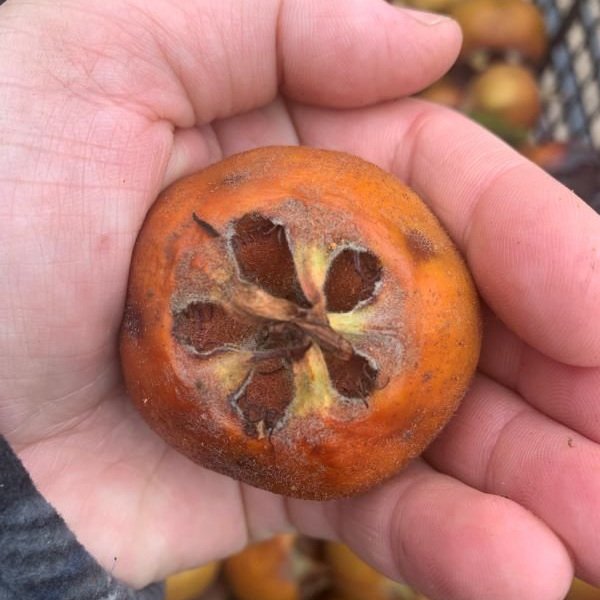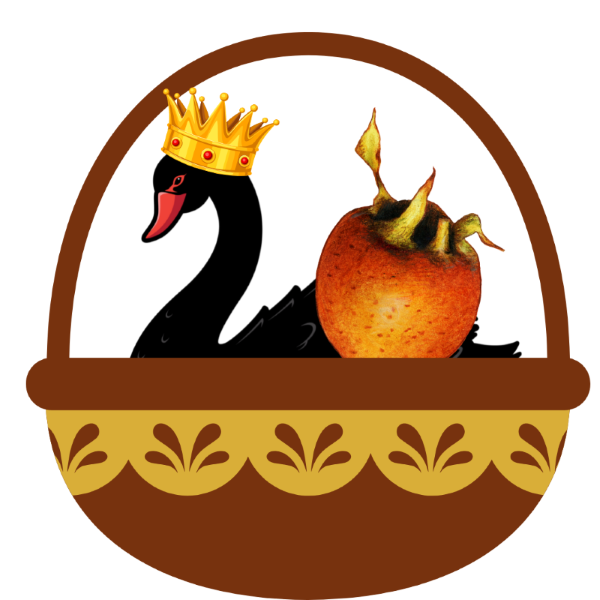Medlar: Ancient, Delicious, &…Rotten?
A Forgotten Fruit With A Tawdry Reputation
Out of more than 100 different varieties of fruit trees grown in the Home Orchard Education Center Arboretum, one of our favorite cold season fruits to showcase comes from a striking tree, called:
MEDLAR
(Mespilus germanica) a member of the Rosaceae family.
Most arboretum visitors have never heard of this unique fruit let alone eaten one. To describe the taste and texture of a medlar is challenging because it’s probably not quite like anything you’ve tasted before.
“Like apple butter with a cinnamon aftertaste.”
“A mixture of toffee and apple with a slightly grainy texture.”
“Like cinnamon applesauce with a hint of wine.”
IN THE LANDSCAPE
The tree itself serves as a focal point, boasting large, showy white flowers in the spring and golden leaves in the fall. The branches tend towards a twisting habit with textured bark.
To make this fruit even more special, medlar are one of the few fruits here in the Pacific Northwest that aren’t ready for picking until late autumn. They hang happily on the tree providing fruit late in the season when almost all other fruits have been harvested.
If you are looking for unique fruits for your edible home garden, the later harvset date of medlar is just another reason to consider saving a space this hardy conversation starter.
A STORIED PAST
There is a bit of uncertainty surrounding the true origin of medlar, but it’s commonly accepted that it’s been cultivated for human consumption for at least 3,000 years throughout regions of Northern Iran, Southwest Asia, & Southeastern Europe (although wild plants do exist in a much more expanded area).
A TAWDRY REPUTATION
Aside from it’s intense flavor profile, medlar was commonly depicted in medieval art and the tree is easily recognized for it’s unique looking fruits that closely resemble a gigantic rosehip, that ranges in color from rosy rust to dusty orange / brown.
The appearance of the fruit has long been the “butt of many jokes” as it was often likened in many medieval writings to“cat or dog arses”. It’s physical appearance, along with the fact that it is eaten “over-ripe” made it the subject of many tawdy and immature references.
“Now will he sit under a medlar tree,
And wish his mistress were that kind of fruit
As maids call medlars, when they laugh alone.
O Romeo, that she were, O that she were
An open-arse and thou a pop'rin pear!”
- Romeo & Juliet
“I’ll graff it with you,
and then I shall graff it with a medlar:
Then it will be the earliest fruit i’ the country;
for you’ll be rotten ere you be half ripe,
and that’s the right virtue of the medlar.”
- As You Like It
Even with these slightly embarrassing associations, medlar was still considered to be a very important & luxurious fruit.
It was grown by ancient Greeks and Romans, beginning in the second century BC, and was also quite fashionable among European nobility.
So fashionable in fact, that in one story from the1500s, a well known King offered a neighboring ruler, “sumptuous gifts” that included swans, geese, capons, ducks, larks, and large quantities of medlar.
THE VANISHING ACT
While medlar is still widely grown and eaten in areas of Iran & Turkey, it’s popularity across Europe and in the United States declined drastically after WWI.
If this fruit is extravagant enough to be gifted in a basket along with a swan, why then have most of our visitors never heard of it? And if it is as interesting as it sounds, why isn’t it more popular here in the U.S.?
1. BECAUSE MEDLAR IS NOT A
"FAST FRUIT"
When harvested in the fall, medlar is very hard, astringent, grainy, and most would say inedible. If you were to bite into the fruit at this stage, you would think we were playing some sort of cruel joke by writing this article telling you to consider growing it at home.
But for those who are patient, the lovely flavor and texture of medlar will show itself after it goes through a process called Bletting described below.
2. BECAUSE MEDLAR NEEDS BLETTING
While the word sounds like something a sheep might call out, the term BLETTING actually refers to a softening process that results in the fruit becoming OVER RIPE which is when medlar is meant to be eaten.
At this stage of over ripeness, although the fruit is not actually “rotten” it certainly appears to be if you don’t know what you are looking at. That “rotten look” is not one that makes people want to fill their bags in the produce aisle. However, it is this bletting process that releases the fruit’s fragrance and flavor and enables the medlar to attain that soft and juicy apple butter texture we are looking for.
While fruit left to hang on the tree long into the winter months, will often go through the process of bletting on its own, if you want to make sure you get to enjoy these delicacies before ants and other critters move in, it's more reliable to pick them in late Fall while they are still hard and bring them inside to finish the process.
HOW TO BLET YOUR BOUNTY
Find a cool place with good air circulation. It can be either light or dark.
Find something to spread the fruit out onto. It could be paper, a towel, a paper bag, or a bin of dry sand.
Place the fruit stems pointing up onto your material in a single layer.
Wait anywhere from a few days to a few weeks and check on them every few days.
You will know they are ready when the fruit is soft / dare we say smooshy to the touch. The skin might even be a bit wrinkly.
The fruits will probably not all ripen at the same time especially if they vary in size, so do the touch test every few days.
Warning: when they are finally ready to eat, they look a bit like something you should toss into the compost bin, so if the rest of your household isn’t aware of your bletting process - you had better let them know, lest some well intended roommate toss your treasure out with the trash!
HOW T O EAT MEDLAR
Medlar is filled with seeds that can make getting to the pulp for use in cooking a challenge. If you only have a few and want to try eating them plain, just cut open the soft well bletted fruit and spoon the pulp into your mouth seeds and all. You will need to spit out the non-edible seeds.
If you managed to get your hands on a big lot and want to try using it in some scrumptious recipes, we find that the easiest way to separate a large amount of pulp is to place the whole intact, soft well bletted medlars into a saucepan (or instapot) skin, seeds, and all. Cover with water and simmer until the skin and seeds come away easily. Using a masher, gently smoosh the fruits and mix them thoroughly with the water. Strain through a colander and return to the pot to simmer until you reach your desired consistency.
RECIPES
Medlar is high in pectin and is often used in jams, jellies, puddings, and spreads, or roasted with cloves and butter or as an accompaniment to meats. It is also highly regarded as a fruit that pairs well with almost any type of wine.
MEDLAR “CHEESE” - A Recipe Inspired From Medieval Times!
This modified recipe is shared from Fratelliai Fornelli
If you would like to try a truly medieval version or learn how it was done in day of olde, check out these instructions at Historic Foods from Theodore Garretts, Encyclopedia of Practical Cookery, (London 188).
Ingredients
approx 4.5 lbs medlar (soft & well bletted)
approx 3 cups water
granulated sugar (amount to be determined later in the recipe)
vanilla
orange zest
salt
Tools:
Large saucepan or pot
Masher
Stirring spoon
2 Large bowls or containers
Large Colander
Cheesecloth or alternative
Cheese molds (or make your own!)
Instructions
Place about 4.5 lbs whole, intact, soft well bletted medlars into a saucepan with 3 cups ml of cold water. Do not remove the skin or seeds.
Using a masher, gently smoosh the fruits and mix them thoroughly with the water.
Let the fruit simmer until very soft and the peel comes away easily from the pulp and seeds.
Set a large bowl or other container onto your countertop.
Place a large colander over the bowl & pour the warm medlar and water mixture from the pot into the colander.
Mix gently and the skin and seeds should separate from the pulp.
Press as much of the pulp as you can through into the bowl, leaving the skin and seeds in the colander.
Discard the skin and seeds.
Set the second bowl or another clean container on the counter.
Take your pulp mixture, and filter it through a clean cheese cloth over the container. This time you will be removing the liquid from the pulp. If you don’t have cheesecloth, here are a few alternatives.
Weigh your drained pulp and place it back into a pot.
Add half of that weight in sugar, a pinch of salt, vanilla and grated organic orange peel. (Many historic recipes include nothing more but sugar and allspice, so that may be an interesting alternative option if you’re not the vanilla type.)
Heat this mixture until the sugar has dissolved continuing to stir to prevent it from sticking.
The consistency at this point should be quite firm; to test, take a spoonful of pulp, turn it upside down and the pulp should stick to the spoon. Once the sugar is thoroughly dissolved and the consistency is as noted above, pour the mixture into your molds and let them set.
Once cooled, flip them out of the molds and onto a wire cooling rack, to let them dry further.
Keep the finished product in the refrigerator and serve sprinkled with powdered sugar and grated orange zest.
MEDLAR STICKY TOFFEE PUDDING
Recipe shared from “A Year at Otter Farm: Inspiring Recipes Through The Seasons”
INGREDIENTS
For the sauce:
125g unsalted butter
70g golden caster sugar
50g dark muscovado sugar
150ml double cream
For the cake:
200g medlar pulp*
60g unsalted butter, softened
85g golden caster sugar
70g dark muscovado sugar
2 eggs
1 tsp bicarbonate of soda
180g plain flour
1 tsp baking powder
1 tsp ground cloves
½ tsp salt
85g walnuts, crushed
Instructions:
Preheat the oven to 350 degrees F.
Lightly butter a baking dish approximately 24cm x 20cm.
Put the sauce ingredients in a pan, and heat gently until the butter melts.
Turn the heat up and boil for 5 minutes, stirring frequently, until the sauce coats the back of a spoon. Pour a little over half of the sauce into the dish, allow to cool and refrigerate to firm up the sauce.
Beat the butter and sugars together, then add in the eggs, one and a time and beat until combined. Stir in the flour, baking powder, bicarbonate of soda, cloves and salt until incorporated. Thoroughly stir in the medlar pulp and the walnuts.
Spoon the mixture into the dish, over the toffee sauce. Bake for 30 minutes until a skewer inserted into the middle comes out clean.
Optional:
Turn the grill on to a moderate heat. Make holes in the cake with a knife – just large enough to allow the sauce to soak into the sponge – and pour over the remaining sauce.
Grill for just long enough to bubble the top a little.
Serve with a lake of double cream or vanilla ice cream.
Growing Medlar
Pollination: Lucky for those with limited space, medlar is self-pollinating so you will get fruit even if you are growing only one single tree with only one variety of the fruit.
Rootstock: When looking for a medlar tree to purchase, you will find medlar either on its own roots, or grafted onto the roots of either hawthorne, quince, or pear. Hawthorne and Quince-A rootstock have a semi-dwarfing effect, while Quince-C rootstock results in an even smaller tree. So if you are hoping for the most compact tree, you will probably want to choose Quince-C and pair it with a variety of quince that has a naturally small growth habit.
Varieties: There are easily a few dozen named varieties of medlar, along with an unlimited number of genetically diverse seedling varieties.
The size and texture of medlar does vary, with some fruits being smaller than a golfball while others nearly fill the palm of your hand. While there are some delicious smaller varieties, the larger fruits do yield more pulp which makes collecting the fruit for cooking a little more fruitful.
Here in the HOEC arboretum, we grow Monstreuse d'Evreinoff. The name translates to 'Huge Evreinoff' and this variety provides us with a hearty yield of large flavorful fruits that you see featured in the photos in this blog post.
Where To Buy Medlar: Here in the Pacific Northwest, we are lucky enough to be surrounded by amazing nurseries offering a wonderful selection of unique food plants. Here are three popular area nurseries that usually carry at least a few different varieties of medlar.
If you would like to see a medlar tree up close and personal and you live in the Pacific Northwest, please visit us some day at the Home Orchard Education Center Arboretum!
Medlars are a late season crop and ripen towards the end of fall / onset of winter, however their beautiful flowers are present throughout the summer.
Happy fruit exploring and we hope to see you in the HOEC Arboretum here in Oregon City sometime!




















